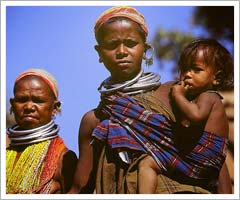Orissa Tribes
 Orissa is a major coastline-state of eastern India, upholding the grandeur and legacy of ancient and modern art and architecture. It runs along the 482 km stretch shoreline of Bay of Bengal. The state is a treasure house of exquisite beaches, torrent waterfalls, meandering rivers, dense foliaged mountain ranges of the Eastern Ghats with a varied wild life. Orissa is a major coastline-state of eastern India, upholding the grandeur and legacy of ancient and modern art and architecture. It runs along the 482 km stretch shoreline of Bay of Bengal. The state is a treasure house of exquisite beaches, torrent waterfalls, meandering rivers, dense foliaged mountain ranges of the Eastern Ghats with a varied wild life.
Orissa bears the credit of ranking an exclusive position for hosting the largest category of tribal population in the ethnographic map of India. One can hit upon them, more or less, in every part of the state, especially in the hilly or forested areas. However, their lifestyles vary from region to region. The tribes of Orissa are chiefly categorized into three linguistic divisions, namely, (1) Indo-Aryan speakers, (2) Dravidian speakers and (3) Austric speakers. All the three classes enjoy a number of socio-cultural resemblances among them. The tribal-society is the potpourri of diverse ethnicity, values and viewpoints that bond the people together. These tribal societies embrace the faction of people who understand the meaning of living together and join hands to work together to achieve any shared interest to cater to the benefits of their society. Every society has its own set of rules with respect to business and trade. The tribes of the state can be categorized into six classes, like the hunters, gatherers and collectors, simple artisans, cattle herders, hill and shifting cultivators, advanced agriculturists and urban factory goers. All these enhance and strengthen their unity to live and toil in sync.
The rituals and festivals practiced by the tribal groups are still being followed, respected and nurtured since the distant past to the present day. The tribal people of Orissa are not only religious but overtly superstitious as well. Every aspect of their life revolving the yearly actions is through and through linked with the numerous rituals and religious convictions.
Another integral part of the festivals and ceremonies is their affluent and diverse tradition of music and dance which they have retained and gracefully maintained since ages. They exhibit their emotions through the medium of music – their happiness and pathos, their cravings and yearnings, their passion and lifestyle, their fondness for nature and outlook towards the human society. Although the art of performing the songs and dances differ from one clan to another, yet certain features are generally familiar to all. The tribal dances are complemented with rhythmic beats of drum-beats, clapping of hands (by the dancers/spectators) or a diminutive arrangement of musical instruments. The tribal people are supposed to be born poets or musicians. They compose and sing their own melodious numbers to pour out their heart’s content.
The tribal people get wings to their flight of fantasy through the medium of art and craft. Their rich handicrafts help one to envisage their artistic susceptibility and creative nature. It gives an insight to their absolute sense of various geometrical measurements and attractive colour combinations. They are equally expert in weaving clothes on looms, making embroidery work or crafting hand made jewelleries.
In Orissa there is a fusion of about sixty two tribes which comprise about 22.21% of the total state population. The typical common distinctiveness shared by the tribal societies distinguishes them from the so-called complex or urban societies. |